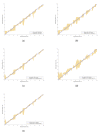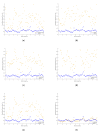Benchmarking for Strain Evaluation in CFRP Laminates Using Computer Vision: Machine Learning versus Deep Learning
- PMID: 36143621
- PMCID: PMC9502268
- DOI: 10.3390/ma15186310
Benchmarking for Strain Evaluation in CFRP Laminates Using Computer Vision: Machine Learning versus Deep Learning
Abstract
The strengthening of concrete structures with laminates of Carbon-Fiber-Reinforced Polymers (CFRP) is a widely adopted technique. retained The application is more effective if pre-stressed CFRP laminates are adopted. The measurement of the strain level during the pre-stress application usually involves laborious and time-consuming applications of instrumentation. Thus, the development of expedited approaches to accurately measure the pre-stressed application in the laminates represents an important contribution to the field. This paper proposes and benchmarks contact-free architecture for measuring the strain level of CFRP laminate based on computer vision. The main objective is to provide a solution that might be economically feasible, automated, easy to use, and accurate. The architecture is fed by digitally deformed synthetic images, generated based on a low-resolution camera. The adopted methods range from traditional machine learning to deep learning. Furthermore, dropout and cross-validation methods for quantifying traditional machine learning algorithms and neural networks are used to efficiently provide uncertainty estimates. ResNet34 deep learning architecture provided the most accurate results, reaching a root mean square error (RMSE) of 0.057‱ for strain prediction. Finally, it is important to highlight that the architecture presented is contact-free, automatic, cost-effective, and measures directly on the laminate surfaces, which allows them to be widely used in the application of pre-stressed laminates.
Keywords: CFRP laminates; computer vision; deep learning; machine learning; strain monitoring; strengthening RC.
Conflict of interest statement
The authors declare no conflict of interest. The funders had no role in the design of the study; in the collection, analyses, or interpretation of data; in the writing of the manuscript; or in the decision to publish the results.
Figures














References
-
- Ghadioui R., Proske T., Tran N., Graubner C.-A. Structural behaviour of CFRP reinforced concrete members under bending and shear loads. Mater. Struct. 2020;53:63. doi: 10.1617/s11527-020-01496-7. - DOI
-
- Fikry M., Ogihara S., Vinogradov V. The effect of matrix cracking on mechanical properties in FRP laminates. Mech. Adv. Mater. Mod. Process. 2018;4:3. doi: 10.1186/s40759-018-0036-6. - DOI
-
- Li C., Yin X., Wang Y., Zhang L., Zhang Z., Liu Y., Xian G. Mechanical property evolution and service life prediction of pultruded carbon/glass hybrid rod exposed in harsh oil-well condition. Compos. Struct. 2020;246:112418. doi: 10.1016/j.compstruct.2020.112418. - DOI
-
- Zhang K., Ma L.H., Song Z.Z., Gao H., Zhou W., Liu J., Tao R. Strength prediction and progressive damage analysis of carbon fiber reinforced polymer-laminate with circular holes by an efficient Artificial Neural Network. Compos. Tructures. 2022;296:115835. doi: 10.1016/j.compstruct.2022.115835. - DOI
-
- Webb G.T., Vardanega P.J., Hoult N.A., Fidler P.R.A., Bennett P.J., Middleton C.R. Analysis of fiber-optic strain-monitoring data from a prestressed concrete bridge. J. Bridge Eng. 2017;22:05017002. doi: 10.1061/(ASCE)BE.1943-5592.0000996. - DOI
Grants and funding
LinkOut - more resources
Full Text Sources

